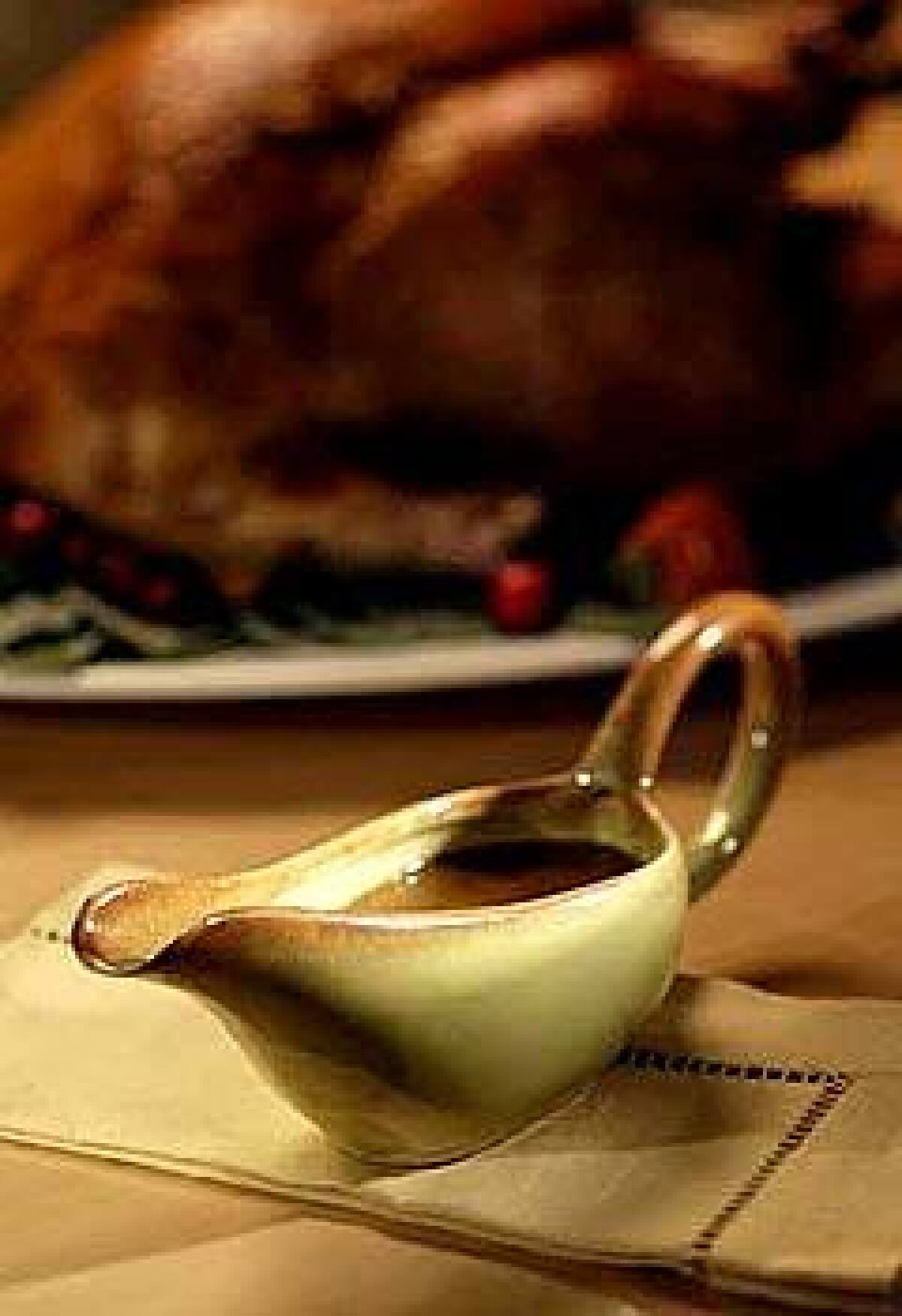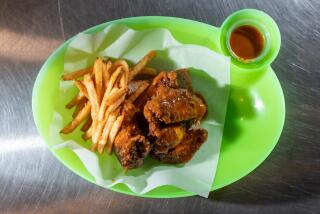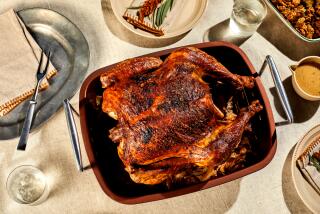Deglazing: It works like magic

- Share via
I’ve never been one for gravy — in the worst cases, it’s lumpy and tastes of uncooked flour; in the best cases, it’s viscous and generic.
I’m a sauce girl.
Sauces are elegant, clean, smart and flavorful. A sauce can elevate sliced white meat that’s cooked within an inch of its life to something, well, groovy. Gravy is just gravy.
To hear people talk when Thanksgiving rolls around, you’d think gravy was obligatory.
It’s not.
There’s nothing easier or quicker to make than a good little sauce. All you need is a pan to deglaze (the one you roasted your bird in), and some liquid — wine or stock; even water will do in a pinch. The pan will still have all the tasty brown bits of meat and caramelized stuff clinging to it. Extra flavorings are nice — shallots, wine, stock, herbs — but you don’t even really need them.
Here’s how it works. You roast a turkey (or chicken or duck or roast beef or veal or pork). Don’t use a nonstick pan if you can avoid it because you actually want to encourage sticking. The browned bits are full of flavor that will wind up in your sauce. The roast comes out of the oven. You remove it to a carving board and let it rest. You have to do this anyway before you carve it. While it’s resting, you make a little deglazing sauce.
Pour most of the fat out of the roasting pan; leave just a tablespoon or so. Place the pan on the stove, over two burners if it’s a big pan. Turn the heat on low, toss in some chopped shallots and “sweat” them — just let them cook until they’re tender, about five minutes or so. Now turn the heat to high, and add liquid.
Wine is what I usually use; red or white, depending on what I’ll be drinking with dinner. If you use a wine that’s similar to what you’ll be serving with the meal, it will make a natural flavor “bridge.” (If you’re drinking something pricey, use a less expensive version for the sauce.) But really, any dry wine — except maybe an over-oaked Chardonnay — will do.
Pour the wine into the pan and, using a wooden spoon, start scraping up all the wonderful browned bits and caramelized stuff from the bottom. Keep deglazing in this way, scraping and reducing, adding more wine if necessary, over high heat until the bottom of the pan is completely smooth. (Incidentally, it will be quite easy to clean after this.) For the simplest sauce, if you’ve just roasted an everyday chicken or really any kind of meat, you can go ahead and add salt and pepper to taste, and pour the sauce into a sauceboat. (Strain or not strain, as you like.)
But if you want a sauce that’s a little richer, take it another step: Add some stock — as much or as little as you want, either chicken broth from a box or can, or homemade chicken stock or veal stock. For an even richer sauce, reduce chicken stock by half before adding it.
Because it’s so easy to make a terrific sauce this way, I like to keep homemade veal stock in my freezer, frozen in one-half cup containers (or you could buy it frozen in one-cup containers). Put the stock right into the reduced wine in the pan — even frozen — and you’re in business. Let it melt and cook down until the sauce is the consistency you like, swirl in a little cold butter (or not); add some fresh chopped parsley or chervil (or not), adjust the seasoning, and voilà.
The beautiful part is that deglazing sauces always turn out well, no matter how much wine or stock you use. They’re easy to adjust. If one tastes a little too tart or tannic from the wine, go ahead and add a little butter, or even a pinch of sugar.
Once you master the easy technique, you’ll want to deglaze everything in sight.
Deglaze the pan when you make any kind of roast, from little Cornish hens to a big juicy roast beef.
Or think small, deglazing sauté pans too (again, those that aren’t nonstick are best). Sauté a pork chop or a piece of fish, and deglaze the pan with a little white wine, and maybe a touch of stock.
For fish, add a squeeze of lemon, maybe some parsley or capers. Sauté a lamb chop or a steak, and deglaze with red wine. The possibilities are endless. For Thanksgiving, you might want to pull out all the stops: Deglaze the turkey roasting pan with Cognac or brandy for a sauce that’s utterly luxurious. Cook it down till it’s almost gone, then add a veal demi-glace — the secret weapon — and strain. Whisk in some some bits of chilled butter — go ahead; it’s Thanksgiving! — making sure the butter’s really cold, and that the sauce doesn’t boil, so the butter doesn’t “break.” You can do it off heat, to be safe, then put it back on the heat as necessary. Velvety, rich and amazingly flavorful, the sauce will be worthy of crowning the turkey you so lovingly prepared. Or, you can use it to rescue a bird that someone else cooked, maybe not so lovingly. This sauce would make cardboard taste good.
The thoughtful Thanksgiving guest travels with Cognac and a pouch of demi-glace, which you can buy at Trader Joe’s, Gelson’s, Bristol Farms or specialty food markets.
Or alternately with a bottle of red wine and a cup of frozen veal stock, available in any serious supermarket.
Then when the panic level in the kitchen ratchets up as the turkey comes out of the oven, and the need to get everything on the table quickly kicks in, you can come to the rescue, gallantly offering to deglaze the pan and whip up a terrific last-minute sauce.
And no one will have to have gravy.
*
Recipes
Basic deglazing sauce
Total time: 15 minutes
Servings: Makes 1 cup
Note: You’ll need to start with a pan in which you’ve just roasted a bird or meat. Butter should be European-style for best results.
2 large shallots, minced
3 branches thyme
2 cups red wine
1 cup veal stock
2 tablespoons very cold unsalted butter, cut into small bits
Sea salt
Freshly ground pepper
1. Pour out all the fat in the roasting pan except for about 1 tablespoon. Place the roasting pan on the stove (over 2 burners, if possible) over low heat. Add the shallots and the thyme to the pan and sweat the shallots until golden, about 3 to 5 minutes.
2. Turn heat to high, then add the red wine. Stir with a wooden spoon, scraping up all the browned bits from the bottom of the pan. Let the wine reduce until a little syrupy, about 5 to 7 minutes.
3. Add the veal stock, and reduce by about half, about 3 to 4 minutes. Turn off the heat, add the butter and swirl it in with a wire whisk. Taste and add salt and pepper to taste. Strain the sauce into a sauceboat.
Each tablespoon: 45 calories; 0 protein; 1 gram carbohydrates; 0 fiber; 2 grams fat; 1 gram saturated fat; 5 mg. cholesterol; 7 mg. sodium.
*Cognac sauce
Total time: 15 minutes
Servings: Makes 1 cup
Note: From John Brenner. You’ll need to start with a pan in which you’ve just roasted a bird or meat. Butter should be European-style for best results. Veal demi-glace is available at Trader Joe’s, Gelson’s, Bristol Farms and specialty food markets.
1 medium shallot, minced (about 2 heaping tablespoons)
1 cup Cognac or brandy
1/2 cup veal demi-glace
4 tablespoons very cold unsalted butter, cut into small bits
Sea salt
Freshly ground white pepper
1. Pour out all the fat in the roasting pan except for about 1 tablespoon. Place the roasting pan on the stove (over 2 burners, if possible) over low heat. Add the shallots to the pan and sweat about 3 to 5 minutes.
2. Turn off the heat, then pour in the Cognac or brandy. Increase the heat to high. Stir with a wooden spoon, scraping up all the browned bits from the bottom of the pan. Reduce the mixture until it’s syrupy, about 3 minutes. Add the demi-glace, stir to incorporate.
3. Strain the sauce into a small saucepan. Warm it on low heat until it just starts bubbling, then remove from heat and whisk in the butter, a few small bits at a time. Add salt and pepper to taste, then pour into a sauceboat and serve immediately.
Each tablespoon: 66 calories; 0 protein; 1 gram carbohydrates; 0 fiber; 3 grams fat; 2 grams saturated fat; 9 mg. cholesterol; 51 mg. sodium.
*White wine-herb sauce
Total time: 15 minutes, plus 45 minutes reducing time
Servings: Makes 1 cup
Note: You’ll need to start with a pan in which you’ve just roasted a bird or meat. Butter should be European-style for best results. While the bird or meat is roasting, you can reduce the chicken broth.
4 cups (32 ounces) low-sodium or unsalted chicken broth or stock
2 large shallots, minced
1 1/2 teaspoons fresh thyme, sage or rosemary, chopped
1 cup white wine
Sea salt
Freshly ground white pepper
1 tablespoon very cold unsalted butter, cut into small bits (optional)
1 to 2 tablespoons chopped Italian parsley
1. Pour the chicken broth or stock into a saucepan over high heat, bring to a boil and cook until reduced by half, about 45 minutes.
2. Pour out all the fat in the roasting pan except for about 1 tablespoon. Place the pan on the stove (over 2 burners, if possible) over low heat. Add the shallots and the thyme, sage or rosemary to the pan and sweat the shallots until golden, about 5 minutes.
2. Turn heat to high, then add the wine. Stir with a wooden spoon, scraping up all the browned bits from the bottom of the pan. Reduce the wine until it’s a little syrupy, about 3 to 4 minutes.
3. Add the reduced chicken broth and reduce until somewhat thickened. And salt and pepper to taste. If you want to give it a nice sheen and aren’t too concerned about fat, whisk in the optional butter. Stir in the parsley and serve immediately.
Each tablespoon (without butter): 19 calories; 1 gram protein; 1 gram carbohydrates; 0 fiber; 0 fat; 0 saturated fat; 1 mg. cholesterol; 28 mg. sodium.
More to Read
Eat your way across L.A.
Get our weekly Tasting Notes newsletter for reviews, news and more.
You may occasionally receive promotional content from the Los Angeles Times.









